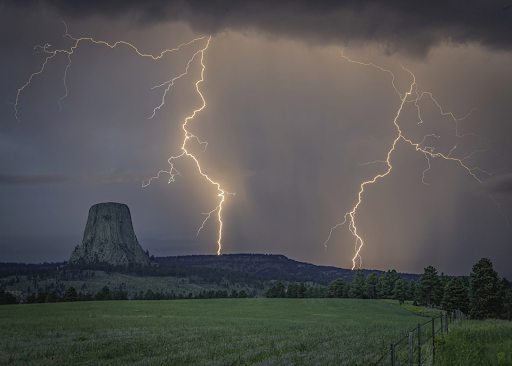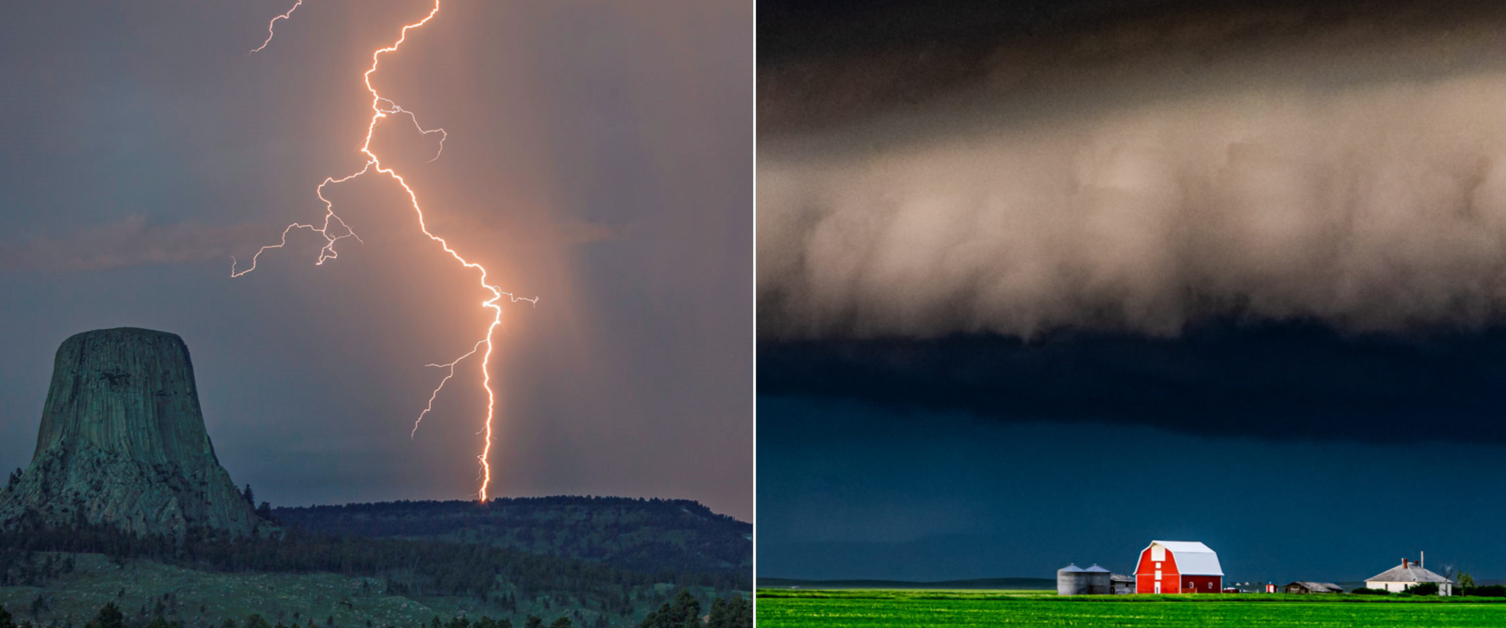Capturing the Lightning: Weather Photography Tips
- By AMS Staff
- Jul 19, 2023
Photos by Laura Hedien and Jeremy Bower
In our 2022 Weather Band Photo Contest Winners Webinar, we spoke to Jeremy Bower (2022 2nd Prize image) and Laura Hedien (2022 Member’s Choice image) about their photos and heard their advice for other weather photographers. Here’s some of their wisdom, from storm chasing gear to the right settings for photographing lightning. Inspired? Learn about our 2023 Weather Band Photo Contest, open through 31 August, 2023.
What are the stories of your winning photos?

“Lighting Up the Tower” by Laura Hedien, 2022 Weather Band Photo Contest winner in the Member’s Choice category, was taken 18 June, 2019, near Devil’s Tower National Monument in Wyoming.
Laura: One of the iconic shots a lot of storm chasers try to catch is a good storm and an iconic symbol of America. Devil’s Tower obviously is a pretty big one, although the road network out there is kind of shady. On that particular day I was with Dr. Walker Ashley and Dr. Victor Gensini [professors at Northern Illinois University]. Instead of chasing the storms, we actually stayed around hoping they would drift our way. And sure enough, during the evening, they did. We found a nice perch and hung around there for about an hour. When you’re shooting these shots—lightning shots in particular—you have no idea what you’re going to get. After the storm passed, we packed up and headed back to the hotel … that was the longest drive of my life, because I knew I had maybe two to three really great shots, but again, you just don’t know if they’re in focus until you get back to the hotel to look at them on the laptop. Thankfully, they were in focus and I was really, really happy with the shots.
Being underneath these storms, they feel like they’re alive. To be able to try to capture them is really a challenge, I really enjoy it. It’s fun being on the road. And you just never see the same thing twice.

“Red Barn Shelfie” by Jeremy Bower, 2022 Weather Band Photo Contest 2nd Prize winner, was taken by Jeremy Bower on 27 June, 2019, near Hobson in Central Montana.
Jeremy: It was June 27th, 2019, up in Central Montana. When you have low-level easterly winds transporting moist, unstable air, there’s magic that can happen, especially up in that mountainous terrain. So we’re on a storm chasing tour and it’s 4:47 p.m. Mountain Time, and there was a supercell kind of heading up towards us. You could see the shelf cloud’s kind of coming off of the mountain range there, off the Bighorns.
Close to the time of the picture, the storm has kind of taken a little bit more of a right turn, it’s about time to get the heck outta Dodge … It’s a little bit darker in the background as the storm’s getting closer—that’s the rain, and probably hail, coming in. We’ve got a little bit more backlight, too. The sun is actually coming out in different spots so we’re getting some really nice contrast going on. And I’m saying, okay, it’s probably time … All I’ve gotta do is zoom in, and there it is.
This was a tricky picture. It took a lot of patience, and then also making sure of the composition … but I then let the shelf cloud do the talking, if you will. That’s the main thing. The red barn was just kind of like the chef’s kiss. It gave that little bit extra. Red Barn Shelfie is one of my top three favorites of all time.
What are some tips for getting good photos of lightning?
Laura: If you get a good shot of lightning, people are gonna think that you’re the greatest photographer ever, when in actuality it’s just luck and the right camera settings. I will shoot in manual mode... It’s always kind of a push-pull give-take between the ISO, the aperture or f/stop, and the shutter speed because the environmental variables are always changing. If you have what we call flashy-flashy lightning within the anvil or within the tower, those can make for nice pictures, but it seems the most dramatic pictures are the forked cloud-to-ground lightning.
Laura’s camera settings for lightning:
- Keep the ISO as low as possible in order to keep the shutter open longer. “My ISO will vary from 100 or lower when I’m starting and it’s still light out, to as high as 6,400 at night.”
- Aperture or f/stop (the diameter of the lens opening) determines focus and how much light you let in. For landscapes, use a mid-range value around f/8 to f/11. If the lightning is very bright and close, decrease the aperture size (towards f/14 or even f/22), or the opposite if it’s far away and/or your ISO is already very high.
- Keep shutter speed between 3 and 20 seconds depending on the conditions. “I do not try to catch lightning,” where it flashes and you push the shutter, Laura says. “I prefer to leave the shutter open … and whatever Mother Nature decides to do during that time, so be it.” Note: If you keep the shutter open longer than 20 seconds, clouds will start to blur.
What equipment do you bring on a storm chasing photography trip?
Jeremy: First and foremost, the tripod. You want to make sure that you invest in a nice tripod, because it’s gonna allow you to get those slower shutter speeds and use those smaller apertures. [The tripod I was using] is pretty sturdy, but the best thing is, for travel purposes, the legs actually bend. You want to keep the equipment light and easy to transport.
Having a shutter release is terrific. It allows you to open and shut the shutter on your camera without actually touching it, especially if you use a wireless one. It works great for lightning as well.
What was also on [the camera I used] was the 24-240 millimeter lens. So that’s an all-in-one zoom. For my purposes—again, traveling light—I was going to be able to get the wide-angle shot and then I was gonna be able to zoom in on the barn. So I didn’t have to worry about changing lenses.
And then the last piece is patience. Patience is crucial when it comes to photography.
How much do you edit?
Laura: When I do edit, I like to present the image as close as possible to how I have seen it. But I still would say that even with the shadows and the de-noising and sharpening, the image itself is maybe 65-70% of the final product and then the remaining 30-35% is gonna be the editing … pulling up the shadows, pushing down the highlights. Again, things that are already there, but you just need to adjust so people can get a clearer picture of what you had seen. Camera technology has improved so much, and it will improve so much more. We’ll probably get to the point where it does show exactly what the eye sees but it’s not there yet, and that’s why editing is so important. Consider taking an editing class, it’s really surprising the before and after that you see.
If I want to photograph storms, what are some things to keep in mind?
Jeremy: Always remember that the environment you’re dealing with is inherently dangerous. No storm is worth dying for. Be aware of your surroundings, have the radar on your mobile device so you know what’s going on, and/or have someone that is nowcasting, they can look at the radar and give you information while you’re out there. You need to know when it’s time to call it quits and move on to the next day. Always have an escape route. Know the local road networks—especially in Montana [where] you have a paved road every maybe 50 to 75 miles—and especially if there happens to be a road under construction. You need to plot that out ahead of time.
My best piece of advice is that if you’ve never chased storms, consider chasing with someone experienced before you try it out on your own. There’s a lot that can happen in a microsecond and there’s just too much to be looking at, especially with the photography aspect of things.
What’s your advice for aspiring photographers and contest entrants?
Laura: When submitting to a contest, don’t get emotionally attached to the images that you take. If you think it’s great because of the emotion, you may ignore some technical things that might be wrong with the image. I would suggest that if you’re submitting contest images, that you have some assistance from an unbiased person. The big thing is, you just gotta get out and shoot. You have to get out and shoot and shoot and shoot more, and then get some constructive criticism on how you could improve your shots.
Jeremy: The two things that are gonna make or break any photo that you take, no matter if you’re doing weather photography or portraits or just general vacation photos, are: is the picture in focus (meaning, is it blurry or not) and did you have your exposure right (meaning, did you have enough light to deal with). If you’ve got the right amount of light and you’ve got the picture in focus, you’re 98.5% there. The rest of it’s the little details.
Are you a Weather Band member and want to hear more from Laura and Jeremy? Watch the webinar.
***

Laura Hedien is a retired firefighter and Naval Reservist Master Chief who is currently pursuing a career in photography. Laura’s images have earned her worldwide recognition through various competitions. FInd her on Twitter, Facebook, Instagram, and on her website, Storm Clouds Photography.

Jeremy Bower has a background in atmospheric science, storm chasing, and weather forecasting, and owns JRBStorm Photography. His photography has been used by the Weather Channel, Emergency management, and the National Weather Service for educational purposes. Find him on Flickr, Facebook, Twitter, and Instagram.
